View this article in another language
- 한국어
- English
- 日本語
- 中文
- العربية
- Español
- Français
- Deutsch
- Pусский
- Tiếng Việt
- Indonesian
This is the first part of our new series "Heritage & Relics of Korea," published in partnership with the National Museum of Korea.
Prehistory and Ancient History
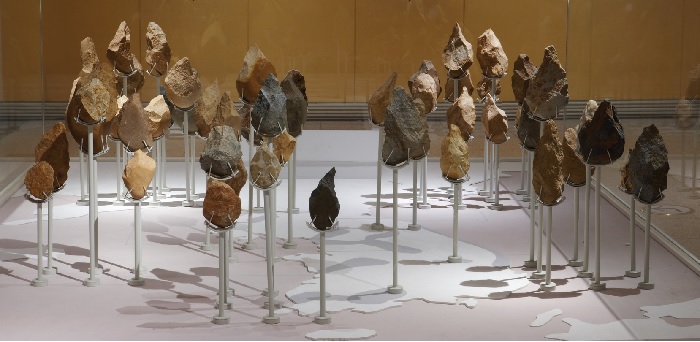
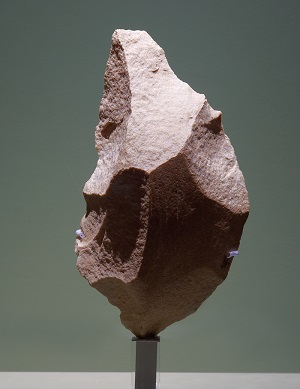 1. Hand Axe
1. Hand Axe
Jeon-gok-ri, Yeoncheon, Gyeonggi-do Province; Paleolithic Age, Length - 23.6 cm
Hand axes are one of the most representative artifacts of the Paleolithic (Old Stone) Age. These bifacial stone tools got their name because they were held directly in the hand and used to chop things. This particular hand axe was excavated from the prehistoric site of Jeongok-ri in Yeoncheon, Gyeonggi-do. This type of artifact is generally thought to have been used as a tool on the Korean Peninsula during the Lower Paleolithic Age (120,000-700,000 years ago). Hand axes were made by using another rock to hammer down the sides and then trimming the edges until they became sharp. Today, this process may sound a bit crude, but the production of stone tools such as hand axes and choppers involved several variegated steps, including selecting the appropriate raw materials and then systematically shaping and sharpening them. Hence, these artifacts are closely related to human evolution and the development of human intelligence. Hand axes were first made by Homo erectus, who achieved fully orthograde (erect) posture, bipedal walking, and advanced intelligence.
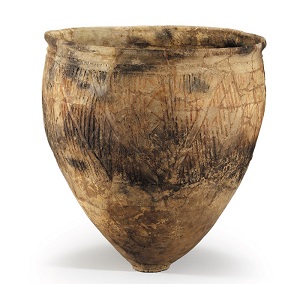 2. Pottery with Raised Design
2. Pottery with Raised Design
Dongsam-dong, Busan; Neolithic Age, Height - 45.0 cm
Pottery with raised designs has been found mostly in the eastern and southeastern coastal regions of the Korean Peninsula, and its main production period was from around 6,000 to 4,000 B.C., predating the appearance of comb-pattern pottery. The raised designs were created either by attaching strips of clay to the outer surface of the vessel or by simply pinching the outer surface to produce thin ridges.
This particular bowl-shaped vessel was excavated from the shell-midden site at Dongsam-dong, Busan. It has a very wide mouth that tapers down into a flat, narrow base. Just below the mouth, a clay band has been horizontally attached, which is decorated with fingernail impressions. The area between this horizontal band and the midpoint of the vessel is divided into a series of triangular panels, which are filled with narrow raised bands.
Prior to the invention of pottery, only vessels made from organic materials (e.g., leaves, wood, or leather) could be used to store or carry food. Not only were ceramic vessels much more solid and durable, they were also well suited for cooking food. Therefore, the use of pottery helped to stabilize the human diet, which in turn made it possible for ancient communities to settle down and maintain relatively long-term residences.
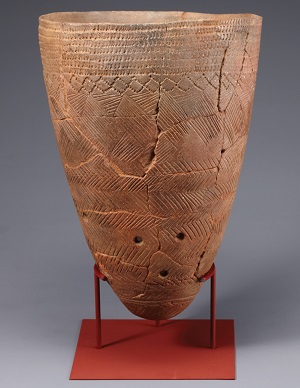 3. Comb-pattern Pottery
3. Comb-pattern Pottery
Amsa-dong, Seoul; Neolithic Age, Height - 38.1 cm
Some of the oldest pottery found on the Korean Peninsula is raised-design pottery (dutmunui togi), which first appeared around 6,000 B.C. Approximately 1,000 years later, that style was replaced by comb-pattern pottery (bitsalmunui togi), which began in the midwestern region of the Korean Peninsula before quickly spreading to the rest of the peninsula.
This particular example of comb-pattern pottery was excavated from the prehistoric settlement site of Amsa-dong, Seoul. It is a simple V-shaped vessel, with a wide mouth and narrow base, and the entire surface is decorated with engraved lines and dots forming geometric patterns. Experts believe that the designs were made to express the worldview of the Neolithic people who interacted with the natural environment of the Korean Peninsula. Both the form and the decorative motifs that characterize this type of pottery are unique to the Korean Peninsula, and have rarely been found outside of the peninsula. Hence, Neolithic societies on the Korean Peninsula are often referred to as “comb-pattern pottery societies.”
The use of comb-pattern pottery, which was so distinctive of the tribes of the ancient Korean Peninsula, began to dwindle by about 1,000 B.C. Ultimately, this type of Neolithic pottery was assimilated with and replaced by the plain, undecorated pottery (minmunui togi) representative of the Bronze Age, which was based on farming.
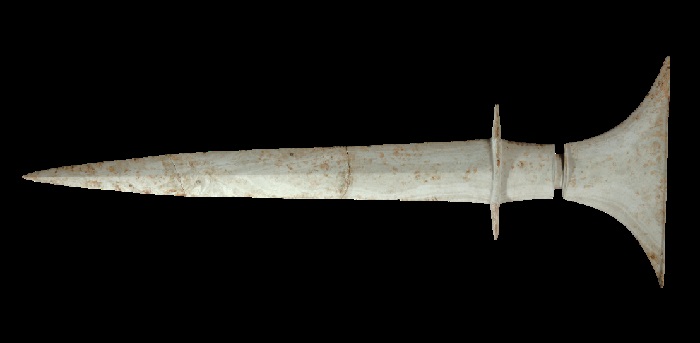
4. Stone Dagger
Jinra-ri, Cheongdo, Gyeongsangbuk-do Province; Bronze Age, Length - 66.7 cm
The representative ground stone tool of the Bronze Age is the stone dagger, the development of which was particularly pronounced on the Korean Peninsula, where they have been found in both dwelling sites and dolmen burial sites. Stone daggers seem to have functioned primarily as tools for practical use. However, several unique types of stone daggers have been found, including oversized daggers, daggers with embellished handles, and daggers decorated with symmetrical patterns that involved manipulating the natural grain of the stone. Such discoveries indicate that stone daggers, like their bronze counterparts, may have sometimes been used as symbolic or ritual objects.
This particular stone dagger is the largest one ever found on the Korean Peninsula. Amazingly, the point of the long blade remains quite sharp, even to this day. The hilt is very short, and it curves out to an exaggerated wide base, like a flattened bell curve, making it rather difficult to grip for practical use. Thus, this stone dagger was probably not used in daily activities, but instead served as a grave good, demonstrating the authority and status of the deceased.
The production of such a large stone dagger would have been a delicate process requiring a lot of time and effort. Only highly skilled and specialized craftspeople could have provided the elite members of the society with such fine stone daggers. Therefore, at that time, the meaning of the stone dagger clearly extended beyond the simple stabbing and cutting functions that we normally associate with daggers. These symbols of leadership and power yield precious insight into the nature and function of Bronze Age society.
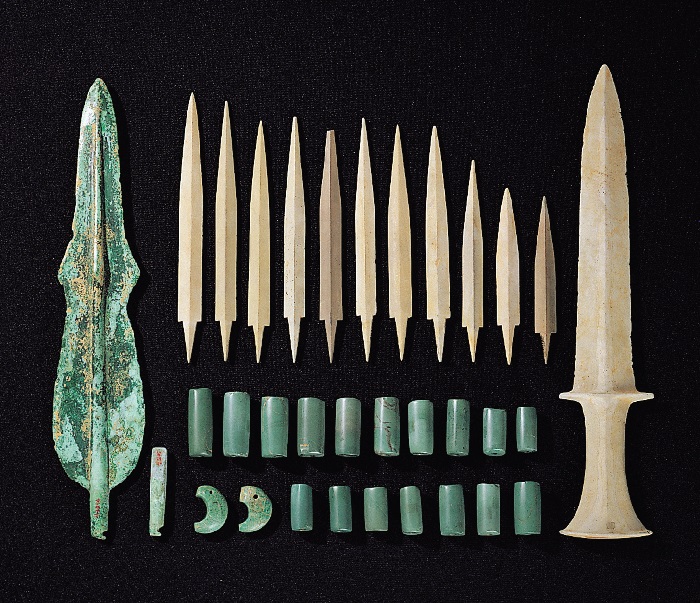
5. Artifacts from Stone Chamber Tomb at Songguk-ri, Buyeo
Songguk-ri, Buyeo, Chungcheongnam-do Province; Bronze Age, Length - 33.4 cm (far left)
The archaeological site at Songgukri in Buyeo is a large-scale settlement site dating to the Bronze Age. The site is very significant for research into the Late Bronze Age in southern parts of the Korean Peninsula. The dwellings, pottery and life patterns of this period are collectively referred to as (respectively) the “Songgukri dwellings,” “Songguk-ri pottery,” and “Songguk-ri life patterns.” The site also includes stone cist burials, one of the two representative burial types of the Bronze Age (along with dolmen burials). This particular stone cist burial yielded numerous artifacts, including: a Liaoning-type bronze dagger, which symbolized the authority of the leader; a bronze chisel, which was recycled from a bronze dagger; as well as a stone dagger, stone arrowheads, and jade beads (both curved and cylindrical). Such an impressive collection of grave goods indicates that the deceased was most likely the head of the regional community.
Pottery, dwellings, and burials that are similar to those investigated at Songguk-ri have been identified throughout the southern parts of the Korean Peninsula, with the exception of a few areas, such as the Han River region and the southeastern part of the Yeongnam region. It is believed that such cultural assemblages are representative of an agricultural society based on wet-rice farming. Notably, aspects of Songguk-ri society also spread to the Kyusu and Kinki regions of the Japanese Archipelago, where they played a significant role in the establishment of the Yayoi people.
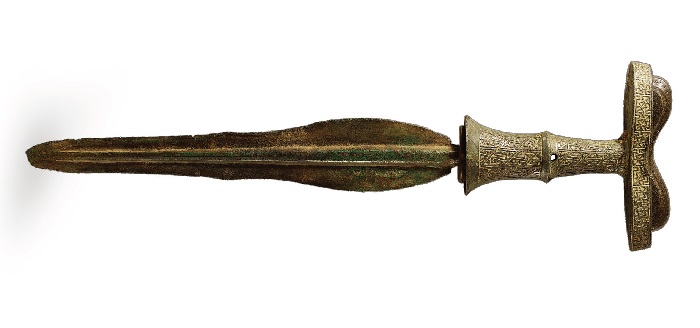
6. Liaoning-type Bronze Dagger
Attributed to Sincheon, Hwanghae-do Province (grip); Bronze Age, Length - 42.0 cm
Bronze Age peoples of the Korean Peninsula can be divided into “Liaoning-type bronze dagger tribes” (1,000-400 B.C.) and “Korea-type bronze dagger tribes,” which developed around the 5th to 4th centuries B.C. The Liaoning-type bronze dagger tribes emerged from China’s Liaoning region, and are marked by daggers with blades that somewhat resemble a lute: thinner at the top, wider and rounded at the bottom. In Korean, these are called either “Bipa-shaped” bronze daggers -- “bipa” means “lute” in Korean -- or “Gojoseon bronze daggers,” since they are also associated with the Gojoseon Kingdom. A typical Liaoning-type bronze dagger has a distinctive lute- or pear-shaped blade, with small triangular protrusions at the vertical midpoint, and a detachable hilt. The detachable handle is a key feature for distinguishing Liaoning daggers from other Chinese daggers, which were typically produced in one piece.
The hilt of this dagger has a distinctive T-shape that is typically associated with Liaoning-type bronze daggers, and it is decorated with a unique lightning or zig-zag pattern. The hilt, which reportedly came from the region of Sichon in Hwanghae Province, represents a very important artifact because, on the Korean Peninsula, it is quite rare to find Liaoning-type bronze dagger blades with handles like this still attached.
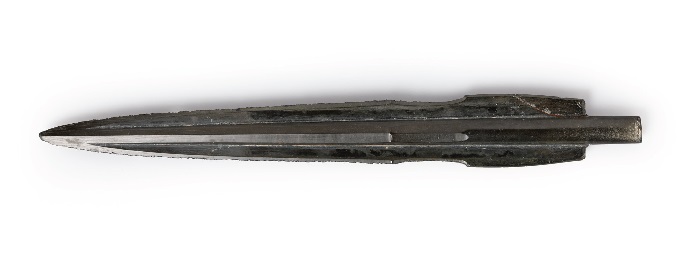
7. A Korea-type Bronze Dagger
Namseong-ri, Asan, Chungcheongnam-do Province; Proto-Three Kingdoms Period, Length - 37.2 cm
This dagger was excavated from a wooden coffin burial at a stone-mound tomb site in Namseong-ri, Asan, Chungcheongnam-do Province, which dates to the Early Iron Age. The tomb at the Namseong-ri site contained numerous bronze objects of the highest quality, suggesting that the deceased was a powerful member of the community. Most of the objects found in the tomb were bronze, and they included: weapons, such as Korea-type bronze daggers; ritual items, such as mirrors with coarse linear designs, shield-shaped bronze artifacts and hilt-shaped bronze artifacts; and, tools, such as axes or chisels. The site also contained curved pieces of jade, cylindrical pieces of jade, burnished black pieces of pottery and pottery with a rim.
Slim daggers made of bronze or “white copper,” such as this item, represent the early iron forging skills that existed at the time. This dagger has sharp edges and “blood grooves” in the blade, revealing that it was used as a practical weapon. Such daggers are widely regarded as representative artifacts among Korea-type bronze daggers, and they are often discovered alongside bronze mirrors with fine linear design and bronze bells.
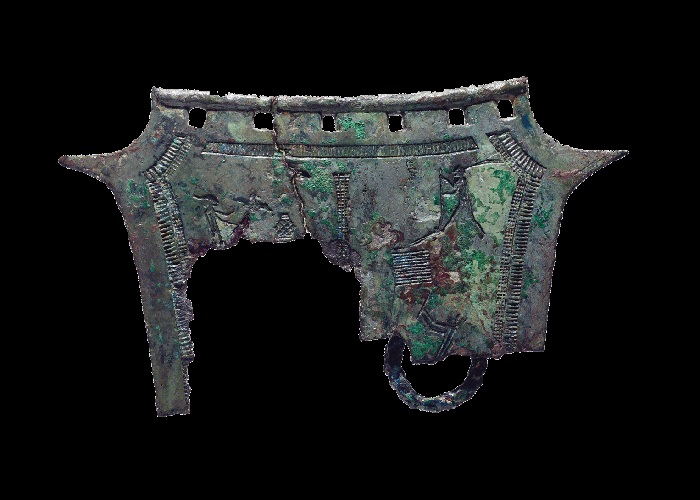
8. Ritual Object with Farming Scenes
Attributed to Goejeong-dong, Daejeon; Early Iron Age, Width - 12.8 cm
Early communities on the Korean Peninsula first began to use metal objects during the Bronze Age (10th to 4th century B.C.). These early metal objects were made of bronze, which is an alloy consisting of copper and smaller proportions of tin, zinc and lead. The production of bronze objects was a complex process that required the use of molds, so only the most elite members of a society could own them. Thus, such objects served either as symbols of authority or as ritual implements.
This particular bronze artifact, which came from Daejeon, has six square holes along its upper edge, and the holes show traces of wear, indicating that the object was probably hung using cords or strings. The front of the artifact is engraved with some agricultural scenes. A nude man who has what appears to be a large feather in his hair is tilling a field. Another man raises a hoe over his head, and a third is putting something into a jar.
The opposite side of the artifact is engraved with two trees with birds perched in forked branches. Experts believe that the image of the naked tiller represents the farming community’s hopes for a good harvest, while the birds in the trees are likely associated with the tradition of setting up guardian poles, or sotdae, in villages as symbols of the villagers’ prayers for peace and prosperity. Based on the holes and the engravings, this was probably a ritual object that was perhaps hung from a tree during farming rituals.
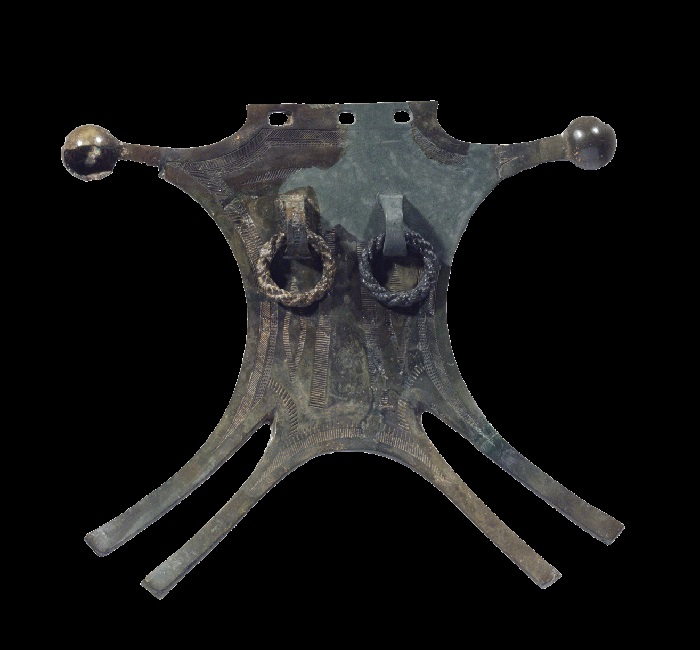
9. Shield-shaped Bronze Artifact
Namseong-ri, Asan, Chungcheongnam-do Province; Early Iron Age, Length - 17.6 cm
This bronze artifact is shaped like a shield, and is believed to have been a ritual object used by the chief priest during religious ceremonies. It was found in a wooden coffin from a stone-mound tomb site in Namseongri, Asan, Chungnam Province. The three holes along the top of the artifact show traces of wear, indicating that the object was hung using strings or cords. The two upper corners of the artifact extend out like branches, each of which forms a bell at the end. The left and right sides of the body of the shield are distinctively concave-curved, resembling the inverted blade of a double-edged axe, with each lower corner culminating in a pair of extended branches. The surface of the shield is traversed by several decorative bands filled with patterns of dots, lines and slashes. There are two prominent knobs on one side of the shield, and one more on the other side, each of which is threaded with a thick, corded ring of bronze.
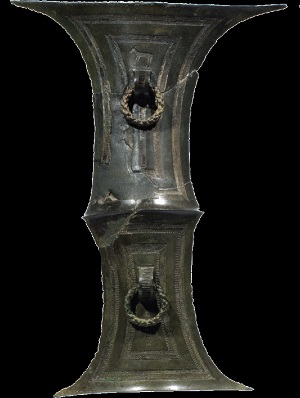 10. Hilt-shaped Bronze Artifact
10. Hilt-shaped Bronze Artifact
Namseong-ri, Asan, Chungcheongnam-do Province; Early Iron Age, Length - 25.4 cm
The Bronze Age peoples of the Korean Peninsula can be divided into “Liaoning-type bronze dagger tribes” (1,000-400 B.C.) and “Korea-type bronze dagger tribes,” which developed around the 5th to 4th centuries B.C. In addition to Korea-type bronze daggers, characterized by their long, slender blades, the representative bronze artifacts of the latter period include weapons like spearheads and halberds, as well as mirrors, bells, and other ritual objects shaped like hilts and shields.
The diverse forms and elaborate decorations of the ritual objects, in particular, demonstrate the highly advanced bronze manufacturing technology of the period. These three bronze artifacts, which appear to be dagger hilts, came from a wooden coffin burial in a stone mound tomb site located in Namseong-ri, Asan, Chungnam Province. One of the bronzes has a small deer engraved near the top. Such animal motifs are known to have been used throughout Siberia as symbols of shamans, and the person in whose tomb these artifacts were found in seems to have been some kind of an authority figure. These two facts have led experts to speculate that the late Bronze Age societies on the Korean Peninsula were theocratic.
These bronze objects probably did not function as actual hilts as they are hollow in the back, like split bamboo. They each have a pair of rings on the front, which might have allowed them to be hung.
Prehistory and Ancient History


Jeon-gok-ri, Yeoncheon, Gyeonggi-do Province; Paleolithic Age, Length - 23.6 cm
Hand axes are one of the most representative artifacts of the Paleolithic (Old Stone) Age. These bifacial stone tools got their name because they were held directly in the hand and used to chop things. This particular hand axe was excavated from the prehistoric site of Jeongok-ri in Yeoncheon, Gyeonggi-do. This type of artifact is generally thought to have been used as a tool on the Korean Peninsula during the Lower Paleolithic Age (120,000-700,000 years ago). Hand axes were made by using another rock to hammer down the sides and then trimming the edges until they became sharp. Today, this process may sound a bit crude, but the production of stone tools such as hand axes and choppers involved several variegated steps, including selecting the appropriate raw materials and then systematically shaping and sharpening them. Hence, these artifacts are closely related to human evolution and the development of human intelligence. Hand axes were first made by Homo erectus, who achieved fully orthograde (erect) posture, bipedal walking, and advanced intelligence.

Dongsam-dong, Busan; Neolithic Age, Height - 45.0 cm
Pottery with raised designs has been found mostly in the eastern and southeastern coastal regions of the Korean Peninsula, and its main production period was from around 6,000 to 4,000 B.C., predating the appearance of comb-pattern pottery. The raised designs were created either by attaching strips of clay to the outer surface of the vessel or by simply pinching the outer surface to produce thin ridges.
This particular bowl-shaped vessel was excavated from the shell-midden site at Dongsam-dong, Busan. It has a very wide mouth that tapers down into a flat, narrow base. Just below the mouth, a clay band has been horizontally attached, which is decorated with fingernail impressions. The area between this horizontal band and the midpoint of the vessel is divided into a series of triangular panels, which are filled with narrow raised bands.
Prior to the invention of pottery, only vessels made from organic materials (e.g., leaves, wood, or leather) could be used to store or carry food. Not only were ceramic vessels much more solid and durable, they were also well suited for cooking food. Therefore, the use of pottery helped to stabilize the human diet, which in turn made it possible for ancient communities to settle down and maintain relatively long-term residences.

Amsa-dong, Seoul; Neolithic Age, Height - 38.1 cm
Some of the oldest pottery found on the Korean Peninsula is raised-design pottery (dutmunui togi), which first appeared around 6,000 B.C. Approximately 1,000 years later, that style was replaced by comb-pattern pottery (bitsalmunui togi), which began in the midwestern region of the Korean Peninsula before quickly spreading to the rest of the peninsula.
This particular example of comb-pattern pottery was excavated from the prehistoric settlement site of Amsa-dong, Seoul. It is a simple V-shaped vessel, with a wide mouth and narrow base, and the entire surface is decorated with engraved lines and dots forming geometric patterns. Experts believe that the designs were made to express the worldview of the Neolithic people who interacted with the natural environment of the Korean Peninsula. Both the form and the decorative motifs that characterize this type of pottery are unique to the Korean Peninsula, and have rarely been found outside of the peninsula. Hence, Neolithic societies on the Korean Peninsula are often referred to as “comb-pattern pottery societies.”
The use of comb-pattern pottery, which was so distinctive of the tribes of the ancient Korean Peninsula, began to dwindle by about 1,000 B.C. Ultimately, this type of Neolithic pottery was assimilated with and replaced by the plain, undecorated pottery (minmunui togi) representative of the Bronze Age, which was based on farming.

4. Stone Dagger
Jinra-ri, Cheongdo, Gyeongsangbuk-do Province; Bronze Age, Length - 66.7 cm
The representative ground stone tool of the Bronze Age is the stone dagger, the development of which was particularly pronounced on the Korean Peninsula, where they have been found in both dwelling sites and dolmen burial sites. Stone daggers seem to have functioned primarily as tools for practical use. However, several unique types of stone daggers have been found, including oversized daggers, daggers with embellished handles, and daggers decorated with symmetrical patterns that involved manipulating the natural grain of the stone. Such discoveries indicate that stone daggers, like their bronze counterparts, may have sometimes been used as symbolic or ritual objects.
This particular stone dagger is the largest one ever found on the Korean Peninsula. Amazingly, the point of the long blade remains quite sharp, even to this day. The hilt is very short, and it curves out to an exaggerated wide base, like a flattened bell curve, making it rather difficult to grip for practical use. Thus, this stone dagger was probably not used in daily activities, but instead served as a grave good, demonstrating the authority and status of the deceased.
The production of such a large stone dagger would have been a delicate process requiring a lot of time and effort. Only highly skilled and specialized craftspeople could have provided the elite members of the society with such fine stone daggers. Therefore, at that time, the meaning of the stone dagger clearly extended beyond the simple stabbing and cutting functions that we normally associate with daggers. These symbols of leadership and power yield precious insight into the nature and function of Bronze Age society.

5. Artifacts from Stone Chamber Tomb at Songguk-ri, Buyeo
Songguk-ri, Buyeo, Chungcheongnam-do Province; Bronze Age, Length - 33.4 cm (far left)
The archaeological site at Songgukri in Buyeo is a large-scale settlement site dating to the Bronze Age. The site is very significant for research into the Late Bronze Age in southern parts of the Korean Peninsula. The dwellings, pottery and life patterns of this period are collectively referred to as (respectively) the “Songgukri dwellings,” “Songguk-ri pottery,” and “Songguk-ri life patterns.” The site also includes stone cist burials, one of the two representative burial types of the Bronze Age (along with dolmen burials). This particular stone cist burial yielded numerous artifacts, including: a Liaoning-type bronze dagger, which symbolized the authority of the leader; a bronze chisel, which was recycled from a bronze dagger; as well as a stone dagger, stone arrowheads, and jade beads (both curved and cylindrical). Such an impressive collection of grave goods indicates that the deceased was most likely the head of the regional community.
Pottery, dwellings, and burials that are similar to those investigated at Songguk-ri have been identified throughout the southern parts of the Korean Peninsula, with the exception of a few areas, such as the Han River region and the southeastern part of the Yeongnam region. It is believed that such cultural assemblages are representative of an agricultural society based on wet-rice farming. Notably, aspects of Songguk-ri society also spread to the Kyusu and Kinki regions of the Japanese Archipelago, where they played a significant role in the establishment of the Yayoi people.

6. Liaoning-type Bronze Dagger
Attributed to Sincheon, Hwanghae-do Province (grip); Bronze Age, Length - 42.0 cm
Bronze Age peoples of the Korean Peninsula can be divided into “Liaoning-type bronze dagger tribes” (1,000-400 B.C.) and “Korea-type bronze dagger tribes,” which developed around the 5th to 4th centuries B.C. The Liaoning-type bronze dagger tribes emerged from China’s Liaoning region, and are marked by daggers with blades that somewhat resemble a lute: thinner at the top, wider and rounded at the bottom. In Korean, these are called either “Bipa-shaped” bronze daggers -- “bipa” means “lute” in Korean -- or “Gojoseon bronze daggers,” since they are also associated with the Gojoseon Kingdom. A typical Liaoning-type bronze dagger has a distinctive lute- or pear-shaped blade, with small triangular protrusions at the vertical midpoint, and a detachable hilt. The detachable handle is a key feature for distinguishing Liaoning daggers from other Chinese daggers, which were typically produced in one piece.
The hilt of this dagger has a distinctive T-shape that is typically associated with Liaoning-type bronze daggers, and it is decorated with a unique lightning or zig-zag pattern. The hilt, which reportedly came from the region of Sichon in Hwanghae Province, represents a very important artifact because, on the Korean Peninsula, it is quite rare to find Liaoning-type bronze dagger blades with handles like this still attached.

7. A Korea-type Bronze Dagger
Namseong-ri, Asan, Chungcheongnam-do Province; Proto-Three Kingdoms Period, Length - 37.2 cm
This dagger was excavated from a wooden coffin burial at a stone-mound tomb site in Namseong-ri, Asan, Chungcheongnam-do Province, which dates to the Early Iron Age. The tomb at the Namseong-ri site contained numerous bronze objects of the highest quality, suggesting that the deceased was a powerful member of the community. Most of the objects found in the tomb were bronze, and they included: weapons, such as Korea-type bronze daggers; ritual items, such as mirrors with coarse linear designs, shield-shaped bronze artifacts and hilt-shaped bronze artifacts; and, tools, such as axes or chisels. The site also contained curved pieces of jade, cylindrical pieces of jade, burnished black pieces of pottery and pottery with a rim.
Slim daggers made of bronze or “white copper,” such as this item, represent the early iron forging skills that existed at the time. This dagger has sharp edges and “blood grooves” in the blade, revealing that it was used as a practical weapon. Such daggers are widely regarded as representative artifacts among Korea-type bronze daggers, and they are often discovered alongside bronze mirrors with fine linear design and bronze bells.

8. Ritual Object with Farming Scenes
Attributed to Goejeong-dong, Daejeon; Early Iron Age, Width - 12.8 cm
Early communities on the Korean Peninsula first began to use metal objects during the Bronze Age (10th to 4th century B.C.). These early metal objects were made of bronze, which is an alloy consisting of copper and smaller proportions of tin, zinc and lead. The production of bronze objects was a complex process that required the use of molds, so only the most elite members of a society could own them. Thus, such objects served either as symbols of authority or as ritual implements.
This particular bronze artifact, which came from Daejeon, has six square holes along its upper edge, and the holes show traces of wear, indicating that the object was probably hung using cords or strings. The front of the artifact is engraved with some agricultural scenes. A nude man who has what appears to be a large feather in his hair is tilling a field. Another man raises a hoe over his head, and a third is putting something into a jar.
The opposite side of the artifact is engraved with two trees with birds perched in forked branches. Experts believe that the image of the naked tiller represents the farming community’s hopes for a good harvest, while the birds in the trees are likely associated with the tradition of setting up guardian poles, or sotdae, in villages as symbols of the villagers’ prayers for peace and prosperity. Based on the holes and the engravings, this was probably a ritual object that was perhaps hung from a tree during farming rituals.

9. Shield-shaped Bronze Artifact
Namseong-ri, Asan, Chungcheongnam-do Province; Early Iron Age, Length - 17.6 cm
This bronze artifact is shaped like a shield, and is believed to have been a ritual object used by the chief priest during religious ceremonies. It was found in a wooden coffin from a stone-mound tomb site in Namseongri, Asan, Chungnam Province. The three holes along the top of the artifact show traces of wear, indicating that the object was hung using strings or cords. The two upper corners of the artifact extend out like branches, each of which forms a bell at the end. The left and right sides of the body of the shield are distinctively concave-curved, resembling the inverted blade of a double-edged axe, with each lower corner culminating in a pair of extended branches. The surface of the shield is traversed by several decorative bands filled with patterns of dots, lines and slashes. There are two prominent knobs on one side of the shield, and one more on the other side, each of which is threaded with a thick, corded ring of bronze.

Namseong-ri, Asan, Chungcheongnam-do Province; Early Iron Age, Length - 25.4 cm
The Bronze Age peoples of the Korean Peninsula can be divided into “Liaoning-type bronze dagger tribes” (1,000-400 B.C.) and “Korea-type bronze dagger tribes,” which developed around the 5th to 4th centuries B.C. In addition to Korea-type bronze daggers, characterized by their long, slender blades, the representative bronze artifacts of the latter period include weapons like spearheads and halberds, as well as mirrors, bells, and other ritual objects shaped like hilts and shields.
The diverse forms and elaborate decorations of the ritual objects, in particular, demonstrate the highly advanced bronze manufacturing technology of the period. These three bronze artifacts, which appear to be dagger hilts, came from a wooden coffin burial in a stone mound tomb site located in Namseong-ri, Asan, Chungnam Province. One of the bronzes has a small deer engraved near the top. Such animal motifs are known to have been used throughout Siberia as symbols of shamans, and the person in whose tomb these artifacts were found in seems to have been some kind of an authority figure. These two facts have led experts to speculate that the late Bronze Age societies on the Korean Peninsula were theocratic.
These bronze objects probably did not function as actual hilts as they are hollow in the back, like split bamboo. They each have a pair of rings on the front, which might have allowed them to be hung.